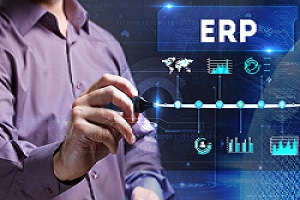Technology is increasingly contributing to the food industry’s journey from the farm to the fork. In this report, we look at how modernization of the food business using high-tech tools can be the driving force for its development and how it can help food manufacturers work more efficiently. Good and greater use of software like ERP, e-commerce, and app portals can ensure affordability and consistent quality, so that the importance of technology for manufacturers continues to grow.
Overview
When it comes to food, technology isn’t always the first thing that comes to mind. However, technology over the years has changed how we produce and find our food through applications like billing, ERP, e-commerce, app portals, and data and processing techniques.
Technology helps food manufacturers produce more efficiently for a growing world population. There are 7.5 billion people in the world right now, and that means a higher demand for food each year. By using technology to improve processing and packaging, it can improve the shelf life and safety of food.
Last year put the food business to the test like never before, from increasing demand to splintered supply networks. All of the turbulence accelerated the digital revolution in the food business.
Faced with challenges on all fronts, food companies stepped up their digital transformation efforts. They focused on optimizing their processes for maximum efficiency and building resiliency into their supply chains.
The goal wasn’t only to survive the pandemic challenge but to come out stronger and ready for whatever challenge may come next.
Digital transformation and modernization of the food industry using high-tech tools take a lot of forms, but there are some common trends, as discussed below:
Billing
At its most basic description: Billing allows you to track the products and services your customers use, generate and send invoices, and receive payments. However, some billing platforms are capable of much more. They can automate the repetitive tasks your finance team struggles with on a daily basis. For example, some billing applications provide time tracking so that you can monitor how much time you’re spending on a client’s work, which is critical if you bill by the hour. In addition, billing may also offer a variety of reports, track debt, manage collections, and connect to key solutions to manage things such as taxation and payment processing.

According to Aziz Khan, founder of Flamboyant Technologies, the company provides its customers with one of the world’s best billing POS solutions (LS Retail) and has developed many processes like real-time gift hampering via POS, order booking, OPT authentication-based discounting, etc.
Khan added, “Also, with the help of modern billing systems, restaurants and food businesses can quickly process customer orders, accept multiple payment options, and provide accurate and fast billing.” “Advanced billing systems can also provide detailed reports on sales and inventory, allowing food businesses to make better decisions regarding their operations.”
Additionally, mobile payment options like digital wallets and contactless payments have become increasingly popular, providing convenience to both the customer and the food business.

Mohit Sharma, CEO of Romio Technologies, explained that faster billing, reducing long billing queues, and secure data, whether the outlet is stand-alone or part of a multiple outlet chain, are the epicenters of the scalability of the products. “To ease operations ahead, the billing application is now centered on multiple integrations with other modules like food aggregator integration, WhatsApp and SMS integration, payment integration, and customer-feedback application integration”, he added.
ERP
The food and beverage industry are evolving at a rapid pace. Evolution in this sector is leading the way for new business challenges and increasing competition. So, people in the food industry are looking for new ways to excel. One of them is implementing ERP in the food industry.
ERP stands for Enterprise Resource Planning and refers to a software system for business management. An ERP system enables food companies to manage and optimize their business processes, from purchasing, accounting, finance, human relations, production, and logistics. In short, ERP is the software that keeps your business up and running. From ordering raw materials to processing orders, managing and optimizing recipes, billing, production planning, and a lot more.
Good ERP systems do not need any third-party software in key areas, and they are capable of supplying all departments and players in a food company with consistent data. What sounds good in theory ensures fast and efficient processes in practice: when a customer order comes in via an online shop or EDI, the system automatically verifies stock availability, notifies the production scheduler, and initiates goods picking, without any media disruptions or interruptions.
For manufacturing companies, it is highly advantageous if their ERP additionally covers the processes in production, thereby taking over the function of a manufacturing execution system. These systems are able to capture and process operational data automatically to improve machine performance and uncover areas for optimization.
This combination of commerce, product management, and production technology intelligence makes the ERP system a central building block for Industry 4.0 in the food industry. It’s no surprise that ERP systems are widely used. ERP has by far the highest degree of maturity in the IT and technology landscapes of companies.

Nilesh Shah, co-founder and COO of RanceLab, Expertise – ERP Software for Sweets & Namkeen Business Serving 1800 sweets brands (10000 outlets) for last 25 years in 45 countries.
He said, “Sweets and namkeen business management encircles an array of business functions that include billing, store management, production, finance, suppliers, loyalty, tax management, promotions, and payroll management. Only ERP software offers the owners and managers the ability to centrally track the operations of all the departments mentioned above at every piece and bit”.
Shah explained that most people mistake basic billing software for ERP and get attracted to low-cost investments without knowing that this is going to cost them hugely in the days to come. The difference between ERP software and billing software is that ERP software offers a 360-degree business solution, while billing software takes care of one or two business functions, like billing and managing customers.
Further, for managing inventory, the business owner has to use spreadsheets or similar tools, and for bookkeeping, they have to invest in financial software. This leads to two major issues: first, that your data is distributed in 3–4 different software packages; and second, that maintaining multiple software packages requires more manpower and money.
As a result, when you want to review all the data, it takes up to 4 weeks to compile it using different software. In today’s times, taking decisions on month-old data is as good as no decision being taken.
On the contrary, Shah elucidated that industry-specific ERP software comes with all the modules needed to operate your business smoothly. It offers centralized data management and reporting that gives you a report on the fly as and when you need it. This ERP software is robust and time-tested. Since it caters to a specific industry, you get everything under one roof. He further informed MNT that, in 2023, it will complement the Sweet & Namkeen business software with smart solutions. RanceLab ERP will help businesses enhance the quality of customer service and empower them to reach beyond their limits and revamp their future.
No behind is Flamboyant Technologies. Khan explains that the company has expertise in the implementation of Microsoft Dynamics (ERP), which is fully integrated with LS Central (POS) and caters to all the demands of the back-office business activities of an organization like inventory control, production and planning, sales and marketing, procurement cycles, etc.
ERP systems are used to manage various aspects of a food business, from inventory management to accounting and even customer relationship management. An ERP system can provide real-time updates on inventory levels, order status, and sales figures, allowing businesses to make informed decisions regarding their operations. With the help of advanced analytics, businesses can even predict future trends and demands, which can help them optimize their supply chain and improve their profitability.
Mohit said, “Enterprise Resource Planning has become an inevitable component of our industry. The business relies on information that comes from inventory, material movement, sales, production, and other operations. And this information needs to be real-time, accurate, and relevant. Our ERP helps the decision maker by providing this, so that their decisions rely on actual facts and data. ERP’s integration with the point-of-sale machine and software provides the transactional data centrally in the ERP for each outlet.”
“Our products, like POS machines, thermal printers, and scanners, are all specially designed, keeping in mind the nature of business and the need to run and support long rush hours. These machines are equipped with the latest configurations so as to adapt to technological advancement”, he added.

E-commerce
More food and beverages are sold through e-commerce than ever before. Indian food and beverage companies can benefit from this channel to reach consumers and businesses interested in their products worldwide. In both business-to-business (B2B) and business-to-consumer (B2C) channels, buyers search and buy more online. Food and beverage firms can connect and talk directly with potential buyers by using:
• e-marketplaces
• social media platforms
• Internet
Selling online can lead to improved margins and a long-term relationship with customers. E-commerce is a crowded market with buyers and sellers from across India and around the world.
Aziz Khan thinks that in recent years, the rise of e-commerce has transformed the food industry, allowing customers to order food online and have it delivered right to their doorstep. E-commerce sites can provide detailed information about a food business’s menu, pricing, and delivery options, allowing customers to make informed decisions about their food choices. With the help of advanced data analytics, food businesses can even personalize their offerings to match customer preferences, providing a more tailored and enjoyable customer experience.
While the food industry involves complex logistic processes and demanding customers, e-commerce (driven by ERP integration) helps companies accomplish their tasks easily. The quick flow of products within the food industry makes it particularly unique, setting it apart from other e-commerce industries. Because consumers certainly do not want to pay for food or beverages that have passed their expiration date, keeping consumers happy is even more critical in this industry.
“While ERP integration helps business processes run smoothly, it can also improve a food business’s position in the market. When your food industry ERP system is integrated with an e-commerce system, you can then display essential product and logistics data in your web store, including current and future inventory levels. When your ERP is integrated with e-commerce, it can help manage the company’s time and information, putting all data and processes in one central location.”
App Portal
India is the world’s fastest-growing e-commerce market, and the format of home delivery or takeaways has gained a lot more influence in locations such as offices, malls, and residential complexes. Start-up programmes focused on the food industry have taken the economy by storm. The number of online web portals opening and their increasing revenue are proof of how vast and deeply profitable this sector is.
Khan explains that the rise of mobile technology is leading food businesses to also develop their own mobile apps to provide a more convenient and personalized experience to their customers. These apps can provide features like online ordering, loyalty programmes, and even real-time tracking of delivery orders. With the help of advanced data analytics, these apps can even make personalized recommendations based on a customer’s past orders and preferences.
Online food-delivery platforms are expanding choice and convenience, allowing customers to order from a wide array of restaurants with a single tap of their mobile phone. While the majority of the population is health conscious, the everyday rigmarole of balancing work and a healthy lifestyle at home is a task, which is why they tend to trust these online food sites more. These sites are swift in their order-taking process and made for the specific convenience of their customers. Also, the lucrative jobs have made their wallets fatter, which allows them to make purchases.
Social media’s growth has made the reach of online food portals far more extensive than it used to be. It provides consumers with an opportunity to share their dining experiences, which in turn may impact and garner more consumers. As a part of the social media umbrella, online reviews and ratings are significant factors that influence consumers’ selection.
Online portals provide transparency and various alternatives to consumers’ choices; this is why, in ordering online, they hope to gain the same experience they get from the outlet itself. Online food websites like Zomato, Swiggy, and Domino’s are among the most popular websites known for being hassle-free and user friendly.
With the continuous influx of professionals in cities and the rapid urbanization of the Indian landscape, the food delivery and restaurant segments are now thriving at a blistering pace. There have been many food websites that have become nonexistent due to their lack of consumer-business relationships. Companies that want to make a niche in the food industry will dive right in, but only the fittest will survive. Businesses that keep their value proposition and their brand active in consumers’ minds, keeping themselves relevant and easily accessible, will have the biggest share in this cut-throat race.
Hence, the modernization of online food portals has had a huge impact on consumers and the food industry.
Final words
The core principle of digital transformation and modernization of the food business using high-tech tools is to replace outdated and analogue processes with modern, fully integrated technology. Doing so immediately reduces or eliminates the inaccuracies, delays, and lost data associated with manual processes.
For example, ERP platforms designed for food and beverage companies can integrate with smart sensors, scales, meters, and thermometers to automatically conduct the readings that help you monitor product quality and process efficiency. Better still, the process isn’t subject to the imperfections of manual record-keeping—human error is removed from the equation, so bad handwriting or a slip of memory won’t spoil the integrity of your data.
What’s more, these integrations also speed up the process to a remarkable degree, importing the results to your central database in real time so that you can act based on the most up-to-date facts and figures. That level of agility and assuredness is what you need in the dynamic food and beverage marketplace.
Like RanceLab ERP, it is smarter and automatically tells the business owners where the problems are and what needs to be fixed. It also comes with intelligent algorithms that help cashiers upsell and cross-sell, identify new and repeat customers, and run different sets of promotions.
“To conclude, it is advisable to invest money once on tested and trusted ERP software rather than in basic software and change it year on year”, advised Shah.
This year, RanceLab will bring important technologies that will help overpower competition, such as mobile ordering, analytics, business intelligence, machine learning, and artificial intelligence.
The right digital transformation strategy can help streamline and automate food safety procedures, giving peace of mind and watertight compliance while simultaneously increasing the efficiency of your operations.
Selecting a food ERP as the basis for digital transformation will unlock features such as expiration management tools, automated compliance checks, and end-to-end traceability functions that facilitate the isolation of contaminations and speed up the recall process. All of these will help ensure that everything coming off your lines is completely fit for consumption.
By looking at the efficiency and profitability results that a purpose-built ERP system can collect, you’ll be able to identify issues in your current processes that are holding you back from peak performance.
These platforms also make financial data easily accessible and highly visible, informing your decisions about which product lines to focus on and which might be best scrapped.
For example, you could easily model the impact of moving your warehouse to a new location or supplying a new customer outside of our usual geographic range. With this functionality, you’re able to accurately calculate the cost-to-serve for new customers and thoroughly test ideas for growth before implementation—helping you drive the most revenue and profit.
Mohit opined that using this high-end technology is not only required for the modernization of traditional businesses, but it is now inevitable in today’s business to sustain itself in the fierce competition without the implementation of the technology.
When stay-at-home orders were issued and transportation delays occurred at the outset of the COVID-19 crisis, food and beverage businesses scrambled to get the materials they needed and fulfil orders amidst the uncertainty. Today, those issues aren’t as much of a concern, but worker shortages and demand volatility continue to leave many organizations on unstable footing.
Using a food ERP platform as the foundation of your digital transformation strategy helps mitigate these challenges, with fully configurable supply chain management features for streamlined pivots in times of transition and process automations to make up for employee unavailability. What’s more, demand planning tools serve to create a firm understanding of what to expect in the seasons to come, and deploying your solution via the cloud provides even greater flexibility.
Khan thinks that the modernization of the food business using high-tech tools has revolutionized the industry, providing a more convenient, personalized, and enjoyable experience for both the food business and its customers.
With the help of advanced billing systems, ERP systems, e-commerce sites, and mobile apps, food businesses can streamline their operations, optimize their supply chain, and improve their profitability while providing a more enjoyable experience to their customers.
“As technology continues to evolve, we can expect even more exciting innovations in the food industry, providing a more sustainable, efficient, and enjoyable experience for everyone involved”, he stated.

Expert comments on ERP by Gulrez Hasan Naqvi
Introduction
The modern food industry is currently experiencing a transformative revolution fueled by rapidly evolving technology and increasing customer demands. One of the key catalysts in this revolution is the adoption of Enterprise Resource Planning (ERP) systems. ERP is business management software that integrates various functions into a single, unified system, streamlining process flows and improving efficiency. The implementation of ERP systems has become vital for businesses in the food sector looking to modernise their operations and stay competitive in an increasingly globalised market.
The role of ERP in the food business
ERP systems play a crucial role in the food industry by integrating essential business functionalities such as procurement, production, inventory management, quality control, sales, and finance. By streamlining these processes, ERP enables food businesses to make well-informed, data-driven decisions and achieve operational excellence.
- Enhancing supply chain efficiency
Efficient supply chain management is critical to the food industry as it directly impacts product quality, safety, and costs. ERP systems facilitate better visibility and control over the supply chain by providing real-time data and accurate information from suppliers, manufacturers, distributors, and retailers. This information helps businesses optimise their logistics, reduce lead times, lower inventory costs, and ensure that customers receive fresh and high-quality products.
- Improving traceability and compliance
Food safety and regulatory compliance are paramount concerns in the food business. ERP systems modernise food safety processes by providing comprehensive traceability solutions that track products throughout their lifecycle, from raw materials to finished goods. This level of traceability helps food companies proactively identify and mitigate potential risks, such as contamination or product recalls, while ensuring compliance with industry regulations and standards.
- Streamlining production and inventory management
ERP systems enable food businesses to optimise production processes while reducing waste and minimising costs. Advanced forecasting tools help companies accurately predict demand, allowing them to tailor production schedules and inventory levels accordingly. This results in fewer stockouts, overstocks, and expired products, leading to higher customer satisfaction and lower operating costs.
- Enhancing quality control and assurance
Quality is a critical factor that influences customer preferences and brand reputation in the food industry. ERP solutions play a vital role in establishing and maintaining stringent quality control measures by providing automated quality management modules. These modules streamline quality inspection processes, generate consistent documentation, and provide real-time data on quality parameters, ensuring that food businesses maintain high standards while complying with regulatory requirements.
- Fostering data-driven decision-making
Modernization of the food industry is also about leveraging data to drive business growth. ERP systems provide robust data analytics capabilities to help food companies identify trends, monitor key performance indicators (KPIs), and generate actionable insights. By harnessing the power of data, food businesses can make informed decisions regarding pricing, promotions, product development, market expansion, and more, driving their overall strategic vision.
Some of the major ERPs for the food industry are SAP S4 HANA, Oracle Business Suite, Microsoft Dynamics, SAP Business One, and Baan-Infor LN.
Conclusion
In the digital age, the modernization of the food business is not merely an option but a necessity. By implementing ERP systems, food companies pave the way for a more efficient, transparent, and agile future that caters to ever-changing consumer demands and market conditions. The integration of ERP solutions allows food businesses to stay competitive in a fast-paced, globalised industry while ensuring that operational excellence and compliance remain the primary focus. As the food business landscape continues to evolve, so too will the role of ERP technology, leading to even further innovation and growth for the industry.
About the Author: Gulrez Hasan Naqvi is a seasoned ERP expert and co-founder of Denpro Technologies Pvt. Ltd. He has spearheaded digital transformation via ERP in diverse industries, including food, for more than 20 years. He can be reached at gulrezhasan@gmail.com.


